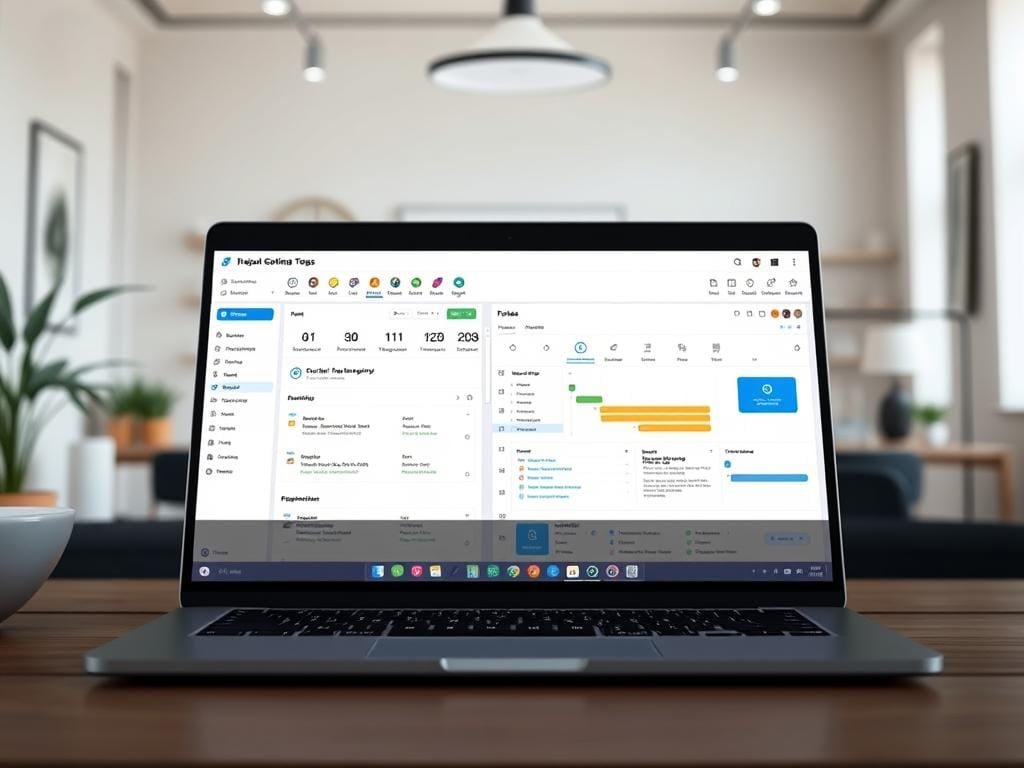In today’s fast world, staying efficient is key. With many productivity tools out there, picking the right ones can be tough.
After trying over 50 tools, I’ve picked my top 9 efficiency tools. They can really change your daily life.
In this article, I’ll share what I’ve found. You’ll learn about the best tools to boost your productivity.
Key Takeaways
- Discover the top 9 efficiency tools that can enhance your daily routine.
- Learn how to choose the right productivity tools for your needs.
- Understand how these tools can help you stay organized and focused.
- Get insights into the benefits of using the right productivity tools.
- Find out how to implement these tools effectively in your daily life.
Understanding Productivity Tools: What They Are
Remote work has become more common, and productivity tools are now key for teams and individuals. These tools help make tasks easier, keep things organized, and increase efficiency.
Definition of Productivity Tools
Productivity tools are software or platforms that help manage work better. They include apps like TickTick for tasks, Fantastical for calendars, and Notion and Obsidian for everything. These tools aim to make complex tasks simpler, help with time management, and improve teamwork.
There are many productivity tools out there, making it hard to choose. But they mainly fall into categories like task management, time tracking, and team collaboration. Knowing these categories helps pick the right tools for your needs.
Importance in Today’s Work Environment
In today’s quick-paced work world, organization apps are vital for staying productive. They help keep track of tasks, deadlines, and projects. For teams, these tools make communication, collaboration, and managing projects easier, ensuring everyone works together towards goals.
| Tool Category | Examples | Benefits |
|---|---|---|
| Task Management | TickTick, Trello | Simplifies task organization, prioritization, and tracking. |
| Time Tracking | Harvest, Toggl | Enhances time management, provides insights into productivity. |
| All-in-One Workspaces | Notion, Obsidian | Offers a centralized platform for notes, tasks, and projects. |
Knowing what productivity tools are and why they matter helps choose the right ones. This can boost your productivity.
My Journey with Productivity Tools
I started my journey in task management with a simple goal: to manage tasks better. But, I quickly got lost in the sea of options. It was overwhelming.
Initial Challenges I Faced
At first, I was hit with the vast number of productivity tools. It was hard to pick the best ones. I spent hours trying out different tools, but many were too complex or missing key features.
I struggled with disorganization and inefficiency. It felt like I was wasting time on tools that didn’t meet my needs. This was a tough time, but it taught me the value of finding the right tool.
Discovering the Need for Tools
As I kept going, I saw how important the right tools are. I found software that was easy to use yet packed with features. This made me more productive and happier at work.

To show what I learned, I made a table of some top productivity tools I’ve tried:
| Tool | Features | User Experience |
|---|---|---|
| Trello | Kanban boards, task assignment, due dates | Intuitive, easy to use |
| Asana | Task management, reporting, integration | Feature-rich, but can be overwhelming |
| Todoist | Task management, prioritization, labels | Simple, yet powerful |
Using these tools helped me organize my work better. Next, we’ll look at how to choose the best productivity tools.
Criteria for Selecting Top Productivity Tools
To find the best productivity tools, look at a few key factors. Check their usability, features, and how they work with other systems. These aspects are crucial for choosing the right tools.
User-Friendliness
One important factor is how easy the tools are to use. Tools that are simple and straightforward let you focus on your work. For example, Notion is known for being both versatile and easy to use, making it popular among many.
A tool that’s easy to use saves you time. It lets you start working quickly without a long learning curve.
Features and Functionality
The features and what a tool can do are also key. You want tools that can handle various tasks, like managing tasks or tracking time. For example, Obsidian stands out for its customization options, fitting your needs perfectly.
Think about what tasks you need to do. Then, see if the tool can help you do them well. Customization and integrations with other apps are big pluses.
Integration Capabilities
How well a tool integrates with others is also crucial. Tools that work well with other platforms help you work better together. For instance, if you use a cloud management platform, choose tools that integrate smoothly with it.
Good integration means less work for you. It automates tasks and cuts down on manual work. Make sure the tool you choose works well with what you already use.
Dive into My Top9 Productivity Tools
In this section, I’ll share my top 9 productivity tools that have changed my game. They’ve made me more efficient and organized. After trying many apps, I found the ones that really make a difference in my daily tasks.
Notion: Overview and Features
Notion is a versatile tool that does it all. It’s for note-taking, project management, and database management. Its flexibility lets you create workflows that fit your needs.
Key Features: Customizable templates, database creation, task management, and collaboration tools.
As “Notion is a powerful tool that can adapt to any workflow”, it’s become a must-have for me every day.
Obsidian: Overview and Features
Obsidian is a note-taking app that links your thoughts and ideas. It creates a web of knowledge that’s easy to navigate. Its graph view feature helps you see connections between notes.
Key Features: Bidirectional linking, graph view, customizable interface, and extensible with plugins.
“Obsidian’s ability to link notes has revolutionized the way I organize my thoughts and ideas.”
Fantastical: Overview and Features
Fantastical is a calendar app that works with your task management system. It lets you schedule and remind yourself easily. Its natural language input makes adding events simple.
Key Features: Natural language input, integration with task managers, and customizable alerts.
Fantastical is my favorite calendar app. Its user-friendly interface and strong features make it stand out.
TickTick: Overview and Features
TickTick is a task management app with many features. It has to-do lists, reminders, and calendar integration. Its Pomodoro timer helps boost your productivity.
Key Features: Task management, reminders, calendar integration, and Pomodoro timer.

These tools have greatly improved my productivity. I believe they can do the same for you. By using each tool’s strengths, you can create a workflow that suits your needs and preferences.
The Role of Collaboration Tools
Effective teamwork is key to success, and collaboration tools help make it happen. Today, teams are spread out, so tools that make communication easy are crucial.

Key Features for Team Collaboration
Collaboration tools have important features for teamwork. These include:
- Real-time Communication: Team members can talk instantly, no matter where they are.
- File Sharing: Team members can share files and documents safely.
- Task Management: Tools help teams organize tasks, track progress, and meet deadlines.
How They Enhance Productivity
Collaboration tools boost productivity by making communication smoother, cutting down on meetings, and improving task management. They keep everyone on the same page, reducing mistakes and speeding up projects.
| Feature | Benefit | Impact on Productivity |
|---|---|---|
| Real-time Communication | Instant feedback and discussion | Reduces delays in decision-making |
| File Sharing | Easy access to documents | Saves time searching for files |
| Task Management | Clear assignment and tracking of tasks | Improves task completion rates |
With these features, teams can work better together, tackle challenges more effectively, and reach their goals faster.
Task Management Tools I Recommend
I’ve tried many productivity tools and I’m excited to share my favorites. Task Management Software is key to my daily routine. It keeps me organized and focused.

Features that Matter
The right features in task management tools are crucial. I seek Organization Apps with intuitive interfaces, customizable workflows, and seamless integration. These help me prioritize tasks, track progress, and work with my team.
My Personal Favorites
TickTick is one of my top picks. It’s versatile and easy to use. I can create and manage tasks across projects, set reminders, and track deadlines. Its integration with other tools also improves my workflow.
Using the right task management tools can greatly improve your productivity. It helps you reach your goals more efficiently.
Time Management Tools to Boost Efficiency
Time management apps can greatly improve your productivity. They help you reach your goals and lower stress. With the right tools, you can focus on what’s important and avoid wasting time.
Importance of Time Tracking
Time tracking is key to managing your time well. It shows you how you spend your time and helps you avoid wasting it. By tracking your time, you can:
- Find ways to improve your workflow
- Set achievable goals and deadlines
- Stay focused and avoid distractions
Tools like Fantastical can make managing your schedule easier. Atlassian says using these tools can really increase your productivity.
Tools That Help Master Your Time
Many time management tools are out there, each with special features. Look for tools that offer:
- Time tracking: To see how you spend your time
- Scheduling: To plan tasks and appointments
- Reminders: Alerts for upcoming events or deadlines
Choosing the right tool can make your work flow better. It helps you avoid wasting time and balance work and life. Try out different tools to find the best one for you.
Advanced Tools for Power Users
As you work to improve your workflow, you’ll find you need advanced tools. These tools have complex features for professionals.
Features Tailored for Professionals
Tools like Workflow Automation Software have features for professionals. They include advanced task management and customizable workflows. For example, Obsidian helps manage knowledge with interconnected notes and databases.
Using these tools can make you more productive. Automation can save time on repetitive tasks. To learn more, visit Boosting Productivity with AI Tools.
Balancing Complexity with Usability
Advanced tools have powerful features but can be complex. It’s key to make them easy to use. Modern tools often have simple interfaces and advanced features.
Some tools have a simple mode for daily tasks and advanced features for big projects. This lets you use the tool as you need, without feeling overwhelmed.
| Tool | Key Features | Usability Score |
|---|---|---|
| Obsidian | Knowledge management, customizable workflows | 8/10 |
| Workflow Automation Software | Automation, task management, collaboration | 9/10 |
Common Pitfalls When Using Productivity Tools
Using productivity tools can really change the game. But, there are common pitfalls to watch out for. You’ve likely faced challenges with organization apps that slow you down.
One big issue is using too many tools. With so many options, it’s easy to try out lots of tools. But, this can confuse you and make you less productive.
Overloading Yourself with Too Many Tools
Using too many productivity tools can make you spread too thin. Each tool takes time to learn, and managing many can be too much. It’s key to focus on a few key tools that meet your needs.
Start with a simple task management tool. Then, add tools that fit well with it. This way, you can build your productivity stack without feeling overwhelmed.
| Tool Category | Recommended Number of Tools | Benefits of Focusing on Few Tools |
|---|---|---|
| Task Management | 1-2 | Simplified task organization |
| Time Tracking | 1 | Accurate time management |
| Collaboration | 1-2 | Enhanced team communication |
Ignoring Tool Integration
Another common mistake is ignoring tool integration. Many organization apps can work together to boost your productivity. By linking your tools together, you can automate tasks and make your workflow smoother.
For example, linking your task management tool with your calendar helps you keep track of deadlines and appointments. To learn more about how tech integration can help, check out this article on the rise of ambient computing.
By being aware of these pitfalls and avoiding them, you can get the most out of your productivity tools. This will help you work more efficiently.
Final Thoughts on Choosing the Right Tools
Choosing the right productivity tools is key to boosting your efficiency and reaching your goals. The right Efficiency Tools can automate tasks, improve teamwork, and make your workflow smoother.
Finding the Right Fit for Your Needs
When picking Productivity Tools, think about what you need and how you work. Look for tools that fit with what you already use and offer the features you value most.
Embracing Continuous Improvement
Improving productivity is an ongoing process. As you try out new Efficiency Tools, keep your goals in mind and be ready to change your approach if needed. This way, you can fine-tune your workflow and boost your productivity.
FAQ
What are productivity tools, and how can they help me?
Productivity tools are software apps that help you manage tasks, time, and projects better. They keep you organized, help you focus on what’s important, and make teamwork easier. This all adds up to more productivity for you.
How do I choose the right productivity tool for my needs?
When picking a productivity tool, think about how easy it is to use, its features, and how well it works with other apps. Consider what you need to do every day and find a tool that fits your style. It’s a good idea to try out a few to see which one works best for you.
What are some essential features to look for in a task management tool?
For task management tools, look for features like setting priorities, due dates, reminders, and team collaboration. Tools like Trello and Asana have these, helping you manage your tasks and projects better.
How can time management tools help me boost my efficiency?
Time management tools, like Toggl and RescueTime, track how you spend your time. They help you find out where you waste time and focus on what’s important. This way, you can do more in less time.
What are some common pitfalls to avoid when using productivity tools?
Don’t overload yourself with too many tools, ignore how they work together, or not make them fit your needs. Be careful not to fall into these traps. Take the time to set up your tools right to get the most out of them.
Can you recommend any collaboration platforms that facilitate team collaboration?
Yes, tools like Slack and Microsoft Teams are great for team work. They provide a place for everyone to communicate, share files, and manage projects. This helps teams stay connected and work better together.
How can I ensure that I’m using productivity tools effectively?
To use productivity tools well, learn what they can do and make them fit your needs. Check your workflows often and change your tools as needed. This keeps them helping you reach your productivity goals.
Are there any advanced productivity tools available for power users?
Yes, tools like Notion and Obsidian are for professionals. They offer features like customizable workflows and advanced task management. These tools help power users work more efficiently and achieve their goals.
How can I balance the complexity of advanced productivity tools with usability?
When using advanced tools, it’s key to find a balance between complexity and ease of use. Look for tools with a simple interface but still offer customization. This way, you can make the tool work for you, not the other way around.
